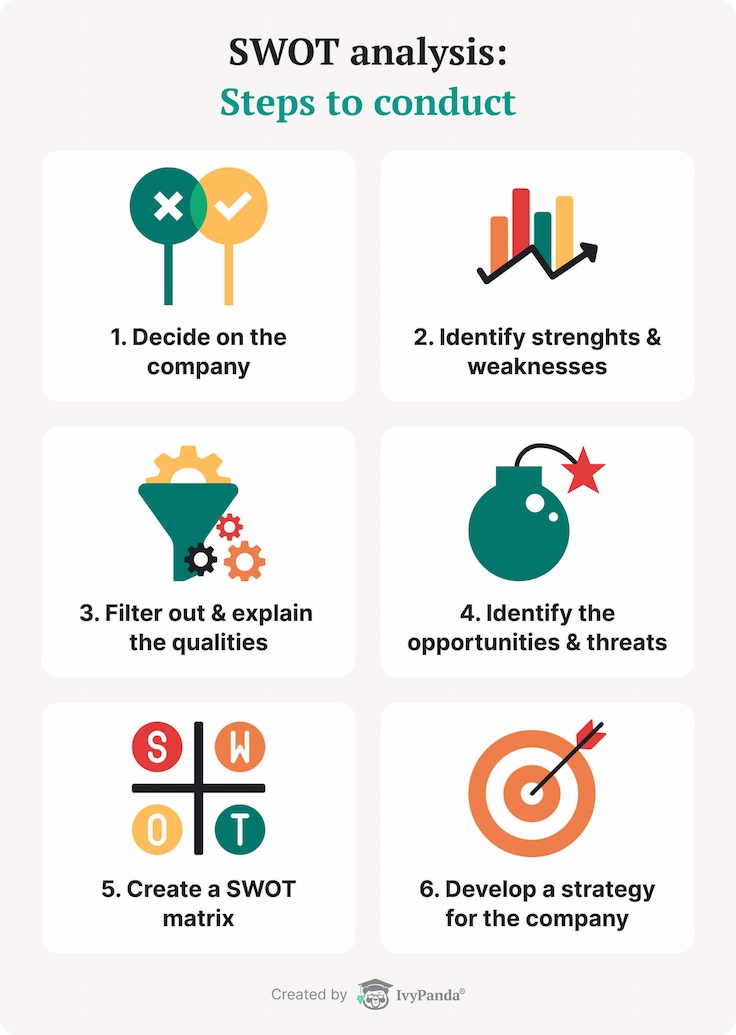SWOT Analysis Generator
Get a customized report with this SWOT analysis generator in 3 steps: fill in the fields, choose your favorite SWOT template, and download the result!
⚙️ SWOT Generator: How Does It Work?
Creating a SWOT matrix can be a real challenge, even before you start designing it. Thankfully, our tool is ready to construct it for you! This SWOT analysis generator has a user-friendly interface, allowing you to form the matrix in just a few clicks.
All you have to do is as follows:
- Fill in the input fields. Type or paste the strengths, weaknesses, opportunities, and threats you’ve gathered while analyzing. Make sure your wording is precise and creative so that it looks good on the final chart.
- Choose the design type. You’ll see a collection of templates that will be appropriate for a SWOT matrix. Pick one that will display your conclusions.
- Select a suitable format. The SWOT generator lets you download the chart in one of the well-known file formats. You just have to decide on the most convenient one for your project.
And that’s it! No payment or registration is required – you will get your detailed SWOT matrix as soon as you click the final button.
❓ SWOT Analysis FAQ
📊 SWOT Analysis: Steps to Conduct
Our free SWOT analysis generator will be most beneficial to you if you’ve already collected all the data required for the template. Thus, below, we’ve provided a step-by-step plan for making the matrix.
Step 1: Decide on the Company
Every SWOT matrix is based on one organization, industry, or product. Thus, you have to determine what you’re going to analyze before anything else. Brainstorm and consider different options before 100% landing on one.

Step 2: Identify the Strenghts and Weaknesses
Each organization has its advantages and disadvantages, which are easier to determine simultaneously. Consider the company’s good and bad qualities and note all your ideas.
Some aspects to consider:
- What goals did the company reach? What didn’t? Why?
- What are the distinctive features and issues?
- What sets the company apart from other businesses? What makes it generic?
- What achievements and failures occurred over the last couple of weeks/months/years?
- What assists the company in accomplishing its objectives? What holds it back?
Step 3: Filter out the Qualities
Throughout the second step, you must’ve gathered numerous features and aspects. Now, it’s time to narrow your research down and clarify some points:
- Regroup your strengths and weaknesses to create distinct areas.
- Remove duplicates and combine the related features under one term.
- Clarify each remaining quality by writing down some explanations.
Lastly, you should pick a few strengths and weaknesses to focus your SWOT analysis on. Usually, analysts concentrate on 2-4 pros and cons. Make sure to work on the wording – it has to be concise and clear to anyone who sees your matrix.
If you’re unsure what it should look like, check some SWOT analysis examples.
Step 4: Determine the Opportunities and Threats
Here, you should repeat steps 2 and 3 regarding the company’s opportunities and threats. Here are some questions that can help you decide on them:
Step 5: Create a SWOT Matrix
By this point, you have all the information required for a comprehensive analysis. However, if it’s disassembled, it won’t help you see the whole picture. You can learn how to create a SWOT matrix, but it may take a while to grasp the concept and design the chart.
That’s why we recommend you use our SWOT analysis generator above! This online maker will ensure that your SWOT matrix has all the nine cells in the correct order. Besides, you won’t have to waste time on the step that will take the automatic tool just a couple of seconds.
Step 6: Develop a Strategy
That’s the last and most crucial step of any SWOT analysis. Consider what goals the company wants to accomplish. Then, regard your SWOT matrix and evaluate whether all the objectives are achievable and why.
With strengths, weaknesses, opportunities, and threats before your eyes, you will see all the internal and external factors influencing the company. So, you can plan how to take advantage of or eliminate them. This way, you will develop a plan to achieve a goal. Or you will have proof that the company will lose more than gain trying to accomplish it.
👀 SWOT Analysis Examples
Below you’ll find links to several SWOT analysis essay examples that focus on various businesses. If you want to get more ideas for your SWOT analysis essay, try our free research title generator.
Thanks for reading! We hope our SWOT generator will be helpful for you and your peers. Send them the link if you think they might need the tool!
Updated: